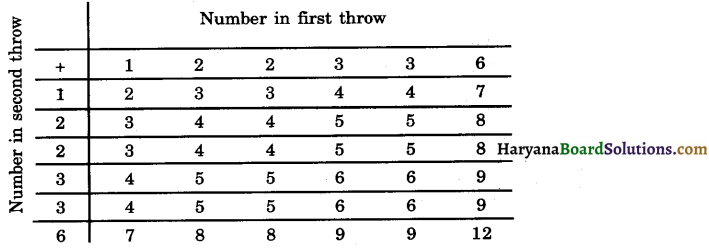Haryana State Board HBSE 10th Class Maths Solutions Chapter 15 Probability Ex 15.2 Textbook Exercise Questions and Answers.
Haryana Board 10th Class Maths Solutions Chapter 15 Probability Ex 15.2
Question 1.
Two customers Shyam and Ekta are visiting a particular shop in the same week. (Tuesday to Saturday). Each is equally likely to visit the shop on any day as on another day. What is the probability that both will visit the shop on :
(i) the same day ?
(ii) consecutive days
(iii) different days?
Solution:
Two customers can visit the shop on two days in 5 × 5 = 25 days
Total number of possible outcomes = 25
(i) Two customers can visit the shop on the same day in one of the following ways.
Tuesday, Wednesday, Thursday, Friday, Saturday
Number of favourable ways = 5
P(visit the shop on the same day) = \(\frac{5}{25}=\frac{1}{5}\).
(ii) Two customers can visit the shop on consecutive days in the following ways:
(Tue, Wed), (Wed, Tue), (Wed, Th), (Th, Wed), (Th, Fri) (Fri, Th), (Fri, Sat), (Sat, Fri)
∴ Number of favourable ways = 8
P (visit the shop on consecutive days) = \(\frac{8}{25}\).
(iii)P (visit the shop on different days) = 1 – P(visit the shop on same day)
= 1 – \(\frac{1}{5}\) = \(\frac{4}{5}\)
Hence, (i) P (visit the shop on the same day) = \(\frac{1}{5}\)
(ii) P (visit the shop on consecutive days) = \(\frac{8}{25}\).
(iii) P (visit the shop on different days) = \(\frac{4}{5}\).
![]()
Question 2.
A die is numbered in such a way that its faces shows the numbers 1, 2, 2, 3, 3, 6. It is thrown two times and the total score in two throws is noted. Complete the following table which gives a few values of the total score on the two throws:

What is the probability that the total score is
(i) even ?
(ii) 6 ?
(iii) at least 6 ?
Solution:
The complete table is given below

Total number of possible outcomes = 6 × 6 = 36.
(i) Let E1 denote the event that total score is a even number
Then favourable outcomes are 2, 4, 4, 4, 4, 8, 4, 4, 8, 4, 6, 6, 4, 6, 6, 8, 8, and 12
The number of outcomes favourable to E1 = 18.
∴ P(E1) = \(\frac{18}{36}=\frac{1}{2}\).
(ii) Let E2 denote the event that total score is 6.
Then favourable outcomes are 6, 6, 6 and 6
The number of outcomes favourable to
E2 = 4
∴ P(E2) = \(\frac{4}{36}=\frac{1}{9}\).
(iii) Let E3 denote the event that total score is at least 6.
Then favourable outcomes are 7, 8, 8, 6, 6, 9, 6, 6, 9, 7, 8, 8, 9, 9 and 12
The number of outcomes favourable to
E3 = 15
∴ P(E3) = \(\frac{15}{36}=\frac{5}{12}\)
Hence, (i) P (E1) = \(\frac{1}{2}\)
(ii) P (E2) = \(\frac{1}{9}\)
(iii) P(E3) = \(\frac{5}{12}\).
![]()
Question 3.
A bag contains 5 red balls andsome blue balls. If the probability of drawing a blue ball is double that of a red ball, determine the number of blue balls in the bag.
Solution:
Let the number of blue balls in the bag be x.
Then total number of balls = (5 + x)
∴ Total number of possible outcomes = (5 + x)
∴ P(a blue ball) = \(\frac{x}{(5+x)}\)
∴ P(a red ball) = \(\frac{5}{(5+x)}\)
According to question,
P (a blue ball) = 2 × P(a red ball)
⇒ \(\frac{x}{(5+x)}\) – 2 × \(\frac{5}{(5+x)}\)
⇒ x = 10.
Hence, number of blue ba1ls in the bag = 10.
![]()
Question 4.
A box contains 12 balls out of which x are black. If one ball is drawn at random from the box, what is the probability that it will be a black ball ?
If 6 more black balls are put in the boiie probability of drawing a black ball is now double of what it was before ? Find x.
Solution:
Total number of balls in the bag = 12
∴ Total number of possible outcomes = 12
There are x black balls
∴ Number of favourable outcomes = x
∴ P (getting a black ball) = \(\frac{x}{12}\)
If 6 more black balls are put in the box. Then
Total number of balls in the box = 12 + 6 = 18
∴ Total number of possible outcomes = 18
Number of black balls in the box = x + 6
∴ Number of favourable outcomes = x + 6
∴ P (getting a black ball) = \(\frac{x+6}{18}\)
According to question,
\(\frac{x+6}{18}=2 \times \frac{x}{12}\)
\(\frac{x+6}{18}=\frac{x}{6}\)
⇒ 18 x = 6x + 36
⇒ 18x – 6x = 36
⇒ 12x = 36
⇒ x = \(\frac{36}{12}\) = 3
Hence, P (getting a black ball) = \(\frac{x}{12}\) and x = 3.
![]()
Question 5.
A jar contains 24 marbles, some are green and others are blue. If a marble is drawn at random from the jar, the probability that it is green is \(\frac{2}{3}\). Find the number of blue marbles in the jar.
Solution:
Total marbles in the jar = 24
Let x be green marbles in the jar.
Then blue marbles in the jar = 24 – x
Total number of possible outcomes = 24
P (getting a green marble) = \(\frac{x}{24}\)
⇒ \(\frac{2}{3}=\frac{x}{24}\)
⇒ x = \(\frac{24 \times 2}{3}\) = 16
Number of blue marbles in jar = 24 – 16 = 8.
Hence, number of blue marbles in the jar = 8